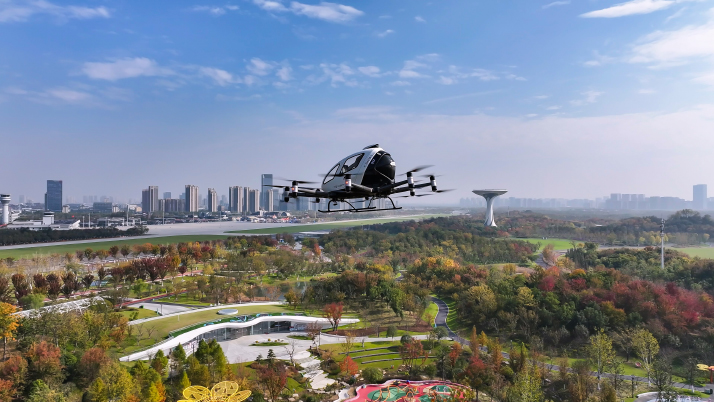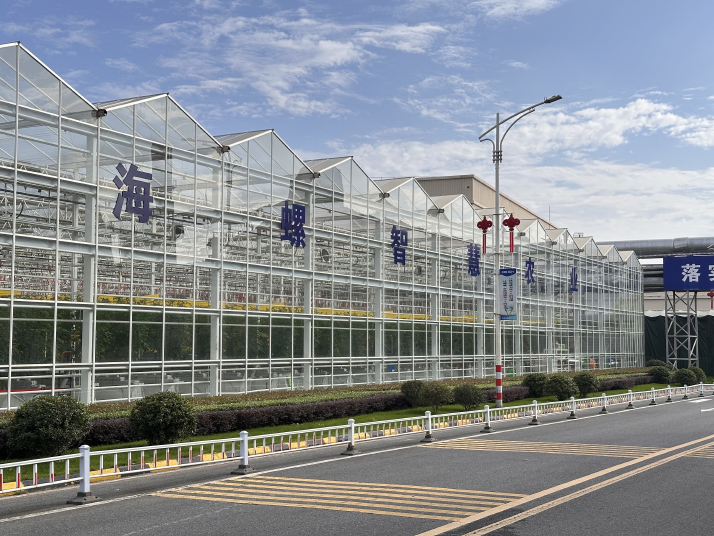| China |
| China's major agricultural province has become an innovation hub | |
|
|
 An electric vertical takeoff and landing aircraft performs a flight demonstration at Luogang Park in Hefei, Anhui Province, on November 11 (COURTESY PHOTO)
On November 11, a two-seat electric vertical takeoff and landing (eVTOL) aircraft, with panoramic windows and 16 propellers arranged around it in a ring, lifted off smoothly for a demonstration flight. Rising to 50 meters, it made a 5-minute loop over Luogang Park in Hefei, capital of Anhui Province, before descending precisely to its starting point. The aircraft, EH216-S, is developed by EHang Holdings, a leading urban air mobility (UAM) company, while its takeoff and landing operations at the park's UAM center are managed by Hefei Heyi Aviation Co. Ltd., an EHang joint venture. While flying cars remain largely the stuff of science fictions elsewhere, in China they are becoming an everyday reality. Anhui, where this flight took place, is also riding the momentum of a new wave of technological revolution and industrial transformation. According to official statistics, the province is now home to more than 20,000 hi-tech enterprises. Anhui will serve as a hub for scientific and technological innovation, a hub for emerging industries and a hub for reform and opening up, while building a zone for green development, according to its development strategy. A rising industrial powerhouse Once a largely agricultural province, Anhui has transformed itself into a rising manufacturing hub. Today it is positioning itself to become a leading force in advanced production. Emerging sectors such as semiconductors, display technologies, electric vehicles and smart manufacturing are expanding rapidly. "Anhui's manufacturing sector continues to evolve, and it is now among the top in China in terms of innovation," Liang Yanshun, Secretary of the Anhui Provincial Committee of the Communist Party of China, said at the 2025 Chinese Enterprise Global Image Summit, held in Hefei from November 7 to 9. Future-oriented fields, particularly the low-altitude economy (defined as economic activities in airspace below 1,000 meters), are gaining momentum. In March, Heyi Aviation received an air operator certificate for civil human-carrying pilotless aerial vehicles from the Civil Aviation Administration of China. The company can therefore offer paid urban sightseeing and other commercial flight services with its self-developed manned drones. Peng Sixuan, Vice General Manager of Heyi Aviation, explained that the aircraft are fully autonomous: They have no cockpit or control stick, and all flight commands are issued from a ground-based control center. "The aircraft now source 98 percent of their core components domestically and have completed over 80,000 safe flights in 21 countries across five continents. Their applications span manned transport, sightseeing and emergency medical response," Peng told Beijing Review. The automotive industry, long a pillar of Anhui's industrial strength, continues to anchor the province's economy. The 2024 Fortune Global 500 list of the largest companies in the world, released in August, showed that local automaker Chery Holding Group reported more than $39 billion in revenue last year. The company has remained China's top passenger car exporter for 21 consecutive years. Anhui's auto industry has deep roots: Its development began in the 1960s with JAC Motors. Today, the province hosts major automakers including Chery, NIO, Volkswagen Anhui, JAC Group and more. Traditional heavy industries such as cement and steel are also undergoing green transformation in Anhui. At Baimashan Cement Plant, operated by Anhui Conch Cement Co. Ltd., there is no roar of machinery or clouds of dust. Instead, sunlight streams into a greenhouse where rows of tomato plants, each 2 to 3 meters tall, bear bright clusters of fruit. What looks like a modern farm is actually part of the factory's intelligent agriculture project. Using its proprietary carbon capture, utilization and storage technology, the factory coverts industrial carbon dioxide emissions into agricultural gaseous fertilizer for tomato cultivation. According to Lu Shumin, head of the factory, the process produces high-quality tomatoes with high sugar content and a long harvest period, while also opening new pathways for industry to support agriculture. "We chose cherry tomatoes because they consume more carbon dioxide than other varieties, and this method allows year-round production," Lu told Beijing Review.  A smart greenhouse at Baimashan Cement Plant, operated by Anhui Conch Cement Co. Ltd., in Wuhu, Anhui Province, on November 12 (COURTESY PHOTO)
Building a Silicon Valley In 2022, the Anhui Provincial Government released an action plan for building the University of Science and Technology of China (USTC) Silicon Valley covering the surrounding area of the school. USTC is a major source of sci-tech innovation in Hefei. USTC faculties and alumni are encouraged to start businesses and incubate their research achievements in the USTC Silicon Valley, where their can receive support from both government departments and the university. Today, the project has grown into a vibrant innovation hub powered by high-caliber professionals and an extensive global network of USTC alumni. Increasing numbers of companies have established headquarters or regional offices there, drawn by the ecosystem of research, talent and entrepreneurship. Over the past two years alone, 1,391 innovative enterprises have settled in the USTC Silicon Valley, accounting for nearly 43 percent of Hefei's quantum technology firms, 55 percent of local aerospace information enterprises and half of the city's bio-manufacturing companies. The growing hard power in science and technology has contributed greatly to the rise of Hefei, and Anhui at large, as a scientific powerhouse. Hefei alone now hosts 12 large-scale scientific facilities. National laboratories and major scientific facilities in the province have produced breakthroughs in quantum information, fusion energy, deep space exploration and other fields. A key example is the Deep Space Exploration Laboratory (DSEL), also known as Tiandu, jointly established by the China National Space Administration, the Anhui Provincial Government and USTC in Hefei in 2022. With high autonomy in research planning, funding, talent recruitment and staff salaries, the lab represents a new model for China's major science initiatives. Deep space research explores regions beyond Earth's immediate environment to better understand celestial bodies and the origins of the universe. Since its launch in 2022, Tiandu has contributed to major national missions, including the Chang'e-6 lunar mission, which brought back the world's first samples from the far side of the moon in June 2024. The lab is developing the world's first dedicated Mars sample research facility and seeking international cooperation.  Lunar samples retrieved by China's Chang'e-5 and Chang'e-6 missions on display at the China Pavilion during the Eighth China International Import Expo in Shanghai, which ran from November 5 to 10. The Deep Space Exploration Laboratory in Hefei, Anhui Province, which explores regions beyond Earth's immediate environment, contributed to the success of the Chang'e 6 and other major national scientific missions (XINHUA)
China has broadened its global partnerships in deep space science in recent years, and DSEL has become a key driver of this effort. Wang Zhongmin, Director of DSEL's International Cooperation Center, introduced the launch of the International Deep Space Exploration Association (IDSEA), the first China-initiated global scientific organization dedicated to deep space research. Established on July 7, IDSEA has expanded rapidly, bringing together 85 institutional members from more than 30 countries, regions and international organizations, along with over 600 scientists from 60 countries. The association focuses on lunar and planetary exploration, asteroid defense and deep space resource utilization, while hosting high-level academic exchanges and building platforms for global scientific collaboration. "Deep space exploration is a great undertaking for humanity," Wang said. "China has always upheld an open and inclusive attitude, welcoming governments, institutions and scientists around the world to join hands." (Reporting from Hefei, Anhui Province) (Print Edition Title: From the Fields to Future Tech) Copyedited by G.P. Wilson Comments to liwenhan@cicgamericas.com |
|
||
|
||||||||||||||||||||||||||||
|